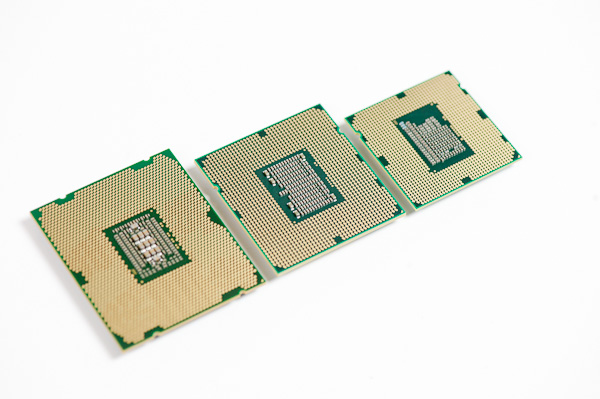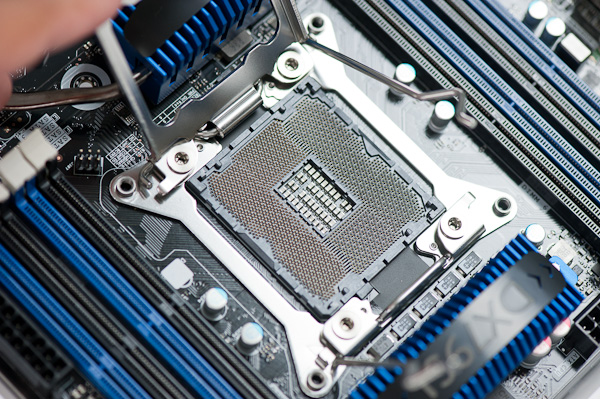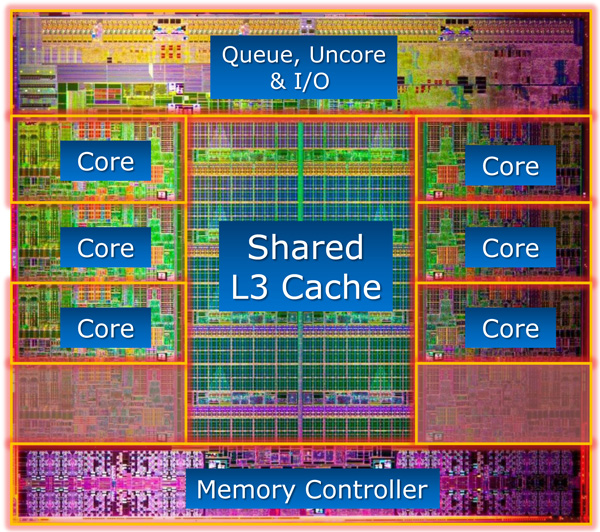Intel Core i7 3960X (Sandy Bridge E) Review: Keeping the High End Alive
by Anand Lal Shimpi on November 14, 2011 3:01 AM EST- Posted in
- CPUs
- Intel
- Core i7
- Sandy Bridge
- Sandy Bridge E
If you look carefully enough, you may notice that things are changing. It first became apparent shortly after the release of Nehalem. Intel bifurcated the performance desktop space by embracing a two-socket strategy, something we'd never seen from Intel and only once from AMD in the early Athlon 64 days (Socket-940 and Socket-754).
LGA-1366 came first, but by the time LGA-1156 arrived a year later it no longer made sense to recommend Intel's high-end Nehalem platform. Lynnfield was nearly as fast and the entire platform was more affordable.
When Sandy Bridge launched earlier this year, all we got was the mainstream desktop version. No one complained because it was fast enough, but we all knew an ultra high-end desktop part was in the works. A true successor to Nehalem's LGA-1366 platform for those who waited all this time.

Left to right: Sandy Bridge E, Gulftown, Sandy Bridge
After some delays, Sandy Bridge E is finally here. The platform is actually pretty simple to talk about. There's a new socket: LGA-2011, a new chipset Intel's X79 and of course the Sandy Bridge E CPU itself. We'll start at the CPU.
For the desktop, Sandy Bridge E is only available in 6-core configurations at launch. Early next year we'll see a quad-core version. I mention the desktop qualification because Sandy Bridge E is really a die harvested Sandy Bridge EP, Intel's next generation Xeon part:
If you look carefully at the die shot above, you'll notice that there are actually eight Sandy Bridge cores. The Xeon version will have all eight enabled, but the last two are fused off for SNB-E. The 32nm die is absolutely gigantic by desktop standards, measuring 20.8 mm x 20.9 mm (~435mm^2) Sandy Bridge E is bigger than most GPUs. It also has a ridiculous number of transistors: 2.27 billion.
Around a quarter of the die is dedicated just to the chip's massive L3 cache. Each cache slice has increased in size compared to Sandy Bridge. Instead of 2MB, Sandy Bridge E boasts 2.5MB cache slices. In its Xeon configuration that works out to 20MB of L3 cache, but for desktops it's only 15MB. That's just 1MB shy of how much system memory my old upgraded 386-SX/20 had.
| CPU Specification Comparison | ||||||||
| CPU | Manufacturing Process | Cores | Transistor Count | Die Size | ||||
| AMD Bulldozer 8C | 32nm | 8 | 1.2B* | 315mm2 | ||||
| AMD Thuban 6C | 45nm | 6 | 904M | 346mm2 | ||||
| AMD Deneb 4C | 45nm | 4 | 758M | 258mm2 | ||||
| Intel Gulftown 6C | 32nm | 6 | 1.17B | 240mm2 | ||||
| Intel Sandy Bridge E (6C) | 32nm | 6 | 2.27B | 435mm2 | ||||
| Intel Nehalem/Bloomfield 4C | 45nm | 4 | 731M | 263mm2 | ||||
| Intel Sandy Bridge 4C | 32nm | 4 | 995M | 216mm2 | ||||
| Intel Lynnfield 4C | 45nm | 4 | 774M | 296mm2 | ||||
| Intel Clarkdale 2C | 32nm | 2 | 384M | 81mm2 | ||||
| Intel Sandy Bridge 2C (GT1) | 32nm | 2 | 504M | 131mm2 | ||||
| Intel Sandy Bridge 2C (GT2) | 32nm | 2 | 624M | 149mm2 | ||||
Update: AMD originally told us Bulldozer was a 2B transistor chip. It has since told us that the 8C Bulldozer is actually 1.2B transistors. The die size is still accurate at 315mm2.
At the core level, Sandy Bridge E is no different than Sandy Bridge. It doesn't clock any higher, L1/L2 caches remain unchanged and per-core performance is identical to what Intel launched earlier this year.
The Lineup
| Processor | Core Clock | Cores / Threads | L3 Cache | Max Turbo | Max Overclock Multiplier | TDP | Price |
| Intel Core i7 3960X | 3.3GHz | 6 / 12 | 15MB | 3.9GHz | 57x | 130W | $990 |
| Intel Core i7 3930K | 3.2GHz | 6 / 12 | 12MB | 3.8GHz | 57x | 130W | $555 |
| Intel Core i7 3820 | 3.6GHz | 4 / 8 | 10MB | 3.9GHz | 43x | 130W | TBD |
| Intel Core i7 2700K | 3.5GHz | 4 / 8 | 8MB | 3.9GHz | 57x | 95W | $332 |
| Intel Core i7 2600K | 3.4GHz | 4 / 8 | 8MB | 3.8GHz | 57x | 95W | $317 |
| Intel Core i7 2600 | 3.4GHz | 4 / 8 | 8MB | 3.8GHz | 42x | 95W | $294 |
| Intel Core i5 2500K | 3.3GHz | 4 / 4 | 6MB | 3.7GHz | 57x | 95W | $216 |
| Intel Core i5 2500 | 3.3GHz | 4 / 4 | 6MB | 3.7GHz | 41x | 95W | $205 |
Those of you buying today only have two options: the Core i7-3960X and the Core i7-3930K. Both have six fully unlocked cores, but the 3960X gives you a 15MB L3 cache vs. 12MB with the 3930K. You pay handsomely for that extra 3MB of L3. The 3960X goes for $990 in 1K unit quantities, while the 3930K sells for $555.
The 3960X has the same 3.9GHz max turbo frequency as the Core i7 2700K, that's with 1 - 2 cores active. With 5 - 6 cores active the max turbo drops to a respectable 3.6GHz. Unlike the old days of many vs. few core CPUs, there are no tradeoffs for performance when you buy a SNB-E. Thanks to power gating and turbo, you get pretty much the fastest possible clock speeds regardless of workload.
Early next year we'll see a Core i7 3820, priced around $300, with only 4 cores and a 10MB L3. The 3820 will only be partially unlocked (max OC multiplier = 4 bins above max turbo).


















163 Comments
View All Comments
ggathagan - Monday, November 14, 2011 - link
You assume correctly.As stated in the article, the 3820 is due out early next year and expected to run at about $300.
If you look at the 1st page of the article, you'll note that the 3820 is a little faster than the 2700K, with the same max in turbo mode and a larger L3 cache.
DanNeely - Monday, November 14, 2011 - link
Except that the 2700k is unlocked and the 3820 has a severe overclocking limit.theangryintern - Monday, November 14, 2011 - link
Thanks for the great review, Anand. I had been waiting for SNB-E to do an upgrade from my X58 Core i7, but now I'm thinking of saving some money and going with a regular Sandy Bridge, the gaming gains just aren't enough to justify the added expense.Makaveli - Monday, November 14, 2011 - link
That makes no sense there are no gaming games going from X58 to SB!You will still be GPU bottlenecked on most games!
And a whole new build will be an added expense for no gain in Games!
Beenthere - Monday, November 14, 2011 - link
Not much to see here except over-priced CPUs and mobos. Nice to see Intel fans smartening up and passing on these cash cows.Lazlo Panaflex - Monday, November 14, 2011 - link
Hi Anand, thanks for the review :)Apologize in advance if this was asked earlier, but what specifically is your criteria for determining a stable overclock? For example, do you run Prime95, large FFT's for a predetermined period of time, or perhaps IBT (Intel Burn Test) for a certain amount of runs? Or do you utilize some other tool? Just curious, since this question often pops up in the CPU forums, and everyone has their own opinion of what constitutes a stable overclock.
Regards,
LP
yankeeDDL - Monday, November 14, 2011 - link
LOL. Supply and the mand is the cause. Jacking up the price is the effect. You are a bit mixed up it seems.Also, in the consumer market having the fastest CPU (or GPU) that you sell for a ridiculous price doesn't mean that someone buys it.
How many people buy a HD6990? Few, and that's why supplies are so scarce.
The 3960X is a "show off" chip that claims performance crown. Anyone in the right state of mind will not buy it: it is just not worth the money it costs, unless you're in absolute need of few extra % of performance.
JlHADJOE - Tuesday, November 15, 2011 - link
We have chips priced at $1000 because the market has shown that it is willing to pay that amount to get the top-performing chip. It doesn't matter that AMD doesn't have an entry in that segment, because if it did, then we'd probably have AMD's FX-9300 or something priced at $900, while Intel sells their 3960X at $1100.This was the exact case when AMD was competitive, and their FX-57 was sold at $1100, vs Intel's Pentium EE which was going for $999. Was there a competitive AMD at the time? Yes. They were even in the lead. Were prices still jacked up? Yes.
The $1000 CPU will only go away if we, as consumers wise up and say we are not willing to pay that much money for a chip.
karkas - Monday, November 14, 2011 - link
Rapid STORY Technology?GTVic - Monday, November 14, 2011 - link
Lack of Quick Sync is not nearly the negative that the reviewer seems to think it is. It is not a well supported technology and not many people would use it on a day to day basis. This shouldn't even be mentioned in the article unless you also want to bring up support for Intel Viiv http://en.wikipedia.org/wiki/Intel_Viiv.